- Go outright long in 2Y covered bonds
Trades
New, Buy NDH5532 (May 2021) outright @-22 bps. P/L:-37/-10bps.
New, Buy SHYP1594 (Sep 2028) against SGB1060 (May 2028) @87.5 bps. P/L:70 /100bps.
New, go for a tighter 10Y BEI box vs Germany, i.e. Buy SGB1060 vs SGBi3104, and sell DBR2028 vs DBRi2030. Start: 92 bps. P/L: 65/110bps.
New, Pay 5Y SEK swap vs receiving 2Y SEK swap @3.3 bps. P/L:17 /-8bps.
Profit taken, Buy SHYP1585 (Dec 2021) ASW @-1.1 bps. Profit: 8.5 bps.
Profit taken, Sell SGBi3104 (Dec 2028) vs DBRi2030 @ -63.1 bps. Profit: 14.4 bps.
Profit taken, Buy SWH189 (Dec 2020) vs SGB1047 (Dec 2020) @ 44 bps. Profit: 5.5 bps.
Danske Bank’s market view in a nutshell

Heading towards a rate cut
Our updated Riksbank call is that the RB brings the policy rate back to -50bp, presumably in February, even though the timing could be affected, for instance, by how the Brexit story unfolds.
Over summer it has become increasingly apparent that Sweden’s economy is shifting down a gear. Certainly an export oriented economy as Sweden is affected by the prolonged economic underperformance in Europe and elsewhere. But that’s not the full story. Private businesses’ capital expenditure has weakened and the Services sector’s confidence is clearly lower. Perhaps most importantly, we have seen a rather abrupt cool-off in the labour market.
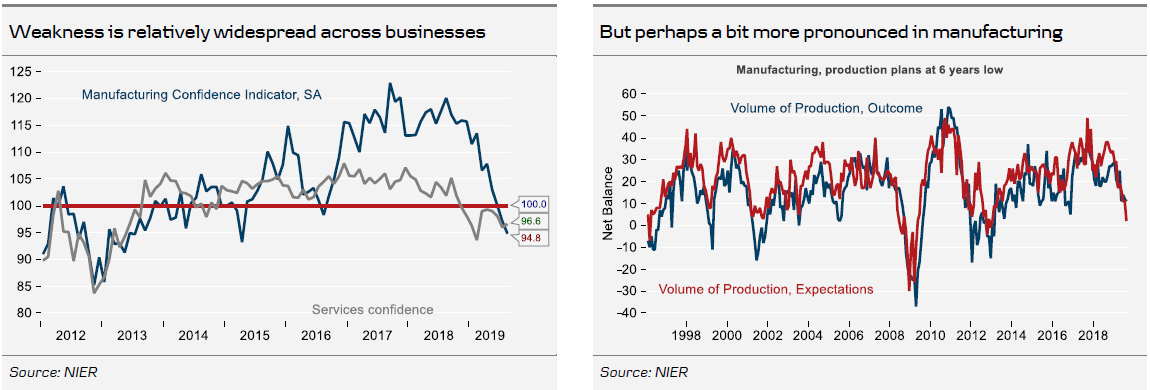
The latest batch of confidence data (NIER business and consumer confidence surveys) just released only confirms the picture. The overall economic tendency indicator dropped to 94.9 (lowest since summer 2013). Softness is relatively widespread, but perhaps a bit more pronounced in manufacturing where production plans are down to a six year low. Looking at all private business sectors, NIER says that employment appears to have levelled out and production plans don’t point to any improvement going forward. In the meantime, consumers expect unemployment to rise over the coming 12 months.
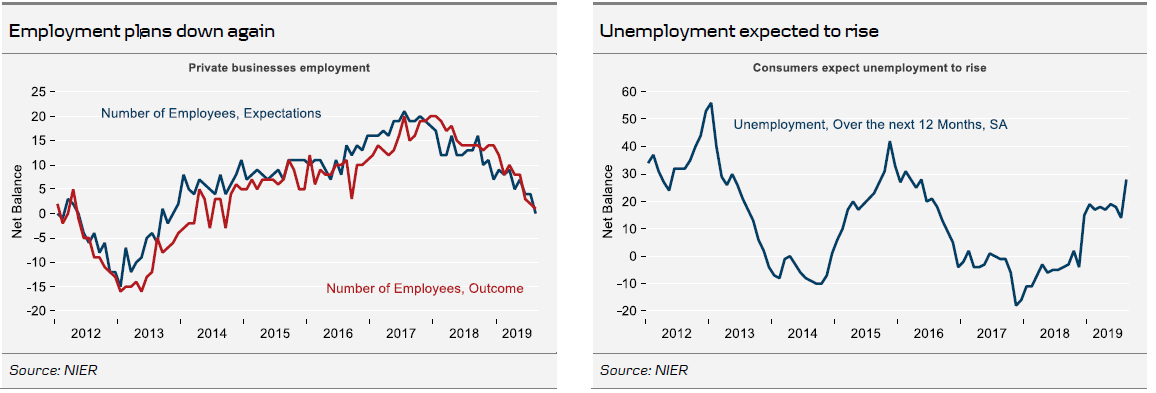
As far as inflation is concerned, the latest couple of readings have been marginally higher than the RB forecast, however the current forecast’s (like Danske Bank’s) projection points to declining inflation numbers going forward. Under different circumstances the RB might have been able to look through a period of low inflation, relying on high resource utilization and relatively healthy growth. This now is becoming increasingly difficult.
In addition, inflation expectations have turned down. If lower inflation expectations among social partners should feed through to wage expectations, the result would be fatal to hopes of higher wage deals next year.
In the meantime, an unresolved US-China trade dispute and a hard Brexit, events that hitherto have been treated as risks and not numerically incorporated in forecasts, are gradually shifting towards working assumptions. As late as in July the RB described global growth as relatively healthy. That view seems quite out of touch considering that leading foreign central banks already have or plan to hit the accelerator because of a global slow down.
As for the September meeting, we see it as very reasonable that the RB postpone the plan to hike around the turn of the year. Our long held view has been that they will continue to kick the can down the road and keep the policy rate unchanged at -0.25bp throughout 2020. Given ongoing global slowdown, political turmoil, policy actions by the ECB and Fed and clear signs of an economic slow-down in Sweden, we think that probabilities have shifted as far as monetary policy is concerned.
In summary: Our updated Riksbank call is that the RB brings the policy rate back to -50bp, presumably in February, even though the timing could be affected, for instance, by how the Brexit story unfolds.
Go outright long in 2Y covered bonds
Given our call for a Riksbank cut, a rather clean way to play this is to go outright long in short-dated covered bonds, as the 2Y covered bond segment trade is well correlated to the repo rate. Currently, the spread is trading in the low end of the historic range, but that is likely due to the market pricing in some 15bp of repo rate cuts from the Riksbank over the next 12 months. Given our forecast of a Riksbank cut of 25bp, we do think there should be potential for some 10-15bp more in the segment. We recommend to go outright long in the 2Y segment, buying NDH5532 (May 2021) at -22bp with a P/L target -37bp/-10bp. Carry is -0.2bp over 3 months.

We have earlier recommended to be long shorter covered bonds against swaps and against government bonds. These recommendations are close to their profit targets, and we choose to close them down in favour of our recommendation above. We take a 5.5bp profit in the SWH189 (Dec 2020) vs SGB1047 (Dec 2020), which we close at 44bp. For the SHYP1585 (Dec 2021) ASW we also think that the fixing, which currently looks to be on the high side, is an additional reason for profit-taking. We close the position at -1bp, with a profit of 8bp.
Hunt for yield to support long-end covered bonds
Swedish covered bond issuers have been front-loading issuance volumes during 2019, where especially the months January to April saw a historically high monthly pace. Based on our estimate of c.SEK415bn in issuance for the full-year, which we have revised somewhat higher than before, the monthly pace of issuance should slow to about SEK25bn per month for the remaining months. This is on the low side compared with previous years for the period September to December. We expect this, in combination with about SEK40bn maturing in September (SHYP1582 and SCBC140), which will likely result in some reinvestment flows, to be supportive for covered bond spreads during the coming months.
A more important factor supportive for covered bonds is the ongoing hunt for yield. Despite volatility being high for the last couple of weeks, covered bonds have fared relatively well. We expect the hunt for yield to continue, especially in light of more central bank stimulus, which obviously will be supportive for covered bonds in general. Apart from the short-end recommendation, where we base our reasoning on a Riksbank cut, we continue to prefer the longest benchmark covered bonds. The curve slope is almost perfectly linear, but we expect that investors will prefer a better yield/pick-up further out on the curve. We note that the share of SEK covered bonds trading with a positive yield has shrunk significantly during 2019 and we think that this is a quite important factor, especially for real money investors. We recommend being long SHYP1594 (Sep 2028) vs SGB1060 (May 2028) at 87bp with P/L target 70bp/100bp. Carry/Roll is 2.3bp over 3 months.
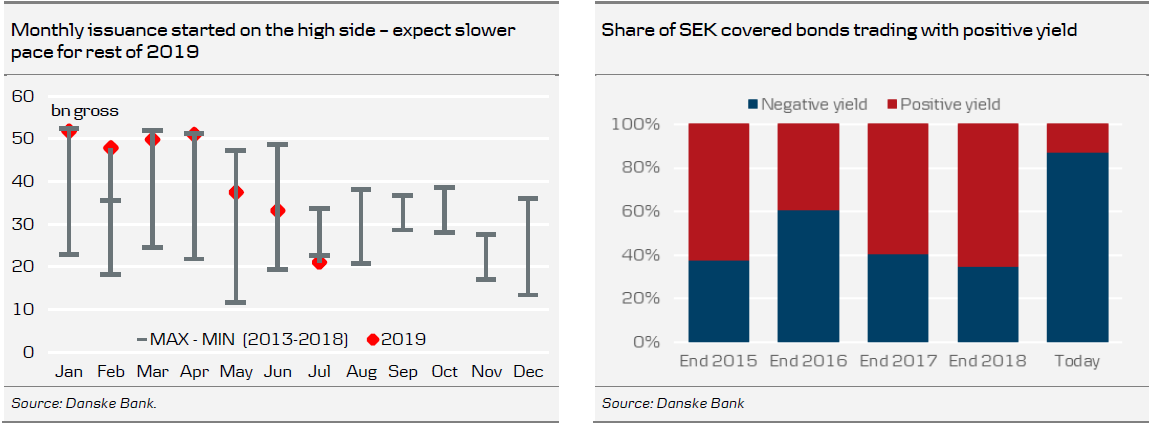
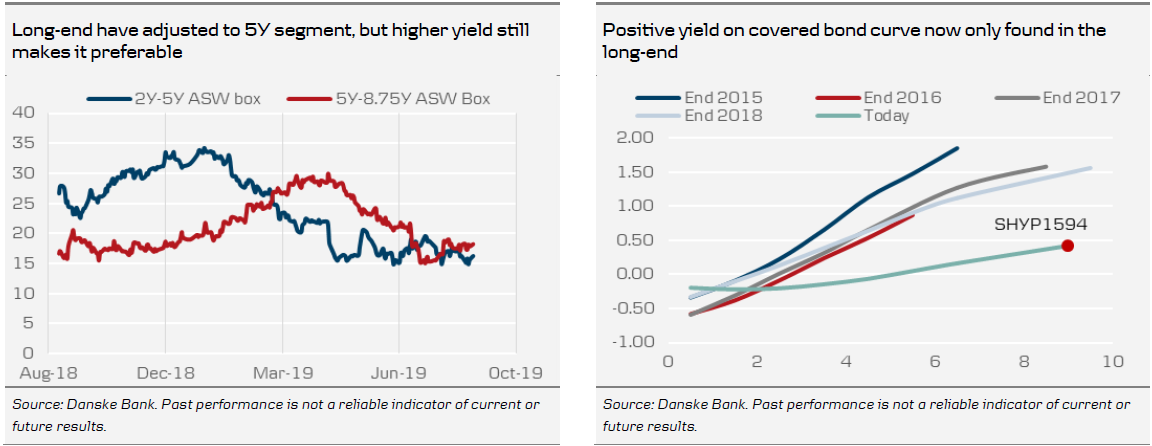
Steepen 2Y-5Y on the SEK swap curve
We have previously recommended a FRA DEC20 vs DEC21 steepener. An alternative trade on the swap curve that has historically been well correlated to this segment of the FRA curve is a 2Y-5Y SEK swap steepener, see chart below. We find it difficult to make a case why this segment of the swap curve would come to invert as it is difficult to see a sustained cutting cycle.

2Y-5Y swap curve steepness highly correlated with the 6th-10th FRA curve steepness
Moreover, the fact that there is room in a higher probability of a rate cut and possibly some downward pressure on fixings could support the SEK short end, which has underperformed substantially relative to EUR.

Also, we note that the risk premium in the 2Y-5Y SEK curve relative to EUR that has been present for a long time has practically disappeared. In our view, pricing on the 5Y point on the SEK curves appears stretched.
The risk premium in 2Y-5Y SEK relative to EUR has practically disappeared
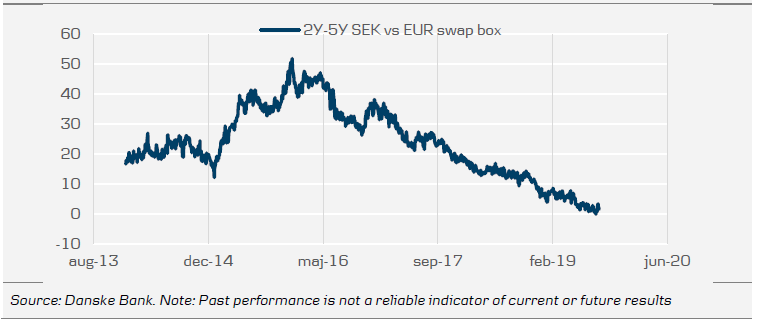
We note that the 2Y-5Y slope of the swap curve tends to generally correlate nicely with the 1Y change in Swedish PMI, see chart below. On top of the observation we made above that it is difficult to see an extended rate cutting cycle, one can add that the current slope of the swap curve would be consistent with PMI close to 40 (latest print: 52 for July).
2Y-5Y swap curve slope not in line with move in PMI
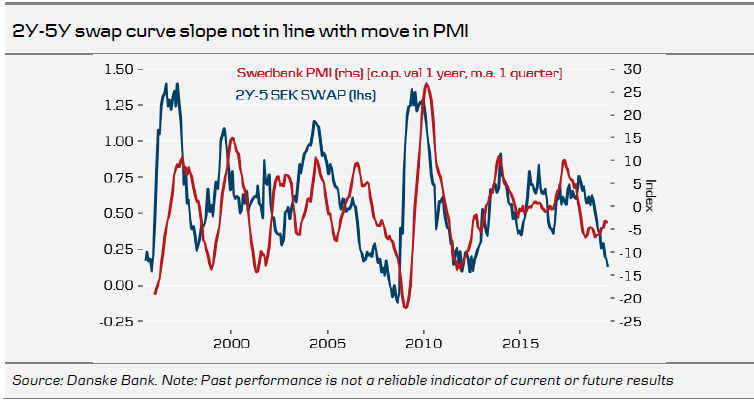
Thus, we recommend a 2Y-5Y swap steepener as an alternative to a DEC20 vs DEC21 steepener on the FRA curve. We set the P/L levels to 17bp/-8bp.
Longer Swedish BEI levels continue to trade at very challenging levels
Long-dated SEK real rates have underperformed somewhat from the record low levels relative to Germany seen earlier. This has benefitted our recommendation to sell SGBi3104 (Dec 2028) vs DBRi2030. However, the correction in break-even spreads has been smaller as nominal SGBs have also underperformed nominal German rates.

The 10Y BEI box vs Germany trades at a whopping 95 bps. As we (and the Riksbank) expect the yoy headline rate of inflation to come down substantially in the months ahead, we think that this pricing will be hard to sustain. We believe that a key reason why Swedish BEIs have remained so resilient is the fact the headline yoy inflation rate has been high.


Moreover, we note that the usual premium in survey-based expectations relative to traded BEI spreads has more or less disappeared. In themselves, survey-based expectations are on a clear downward trend that is likely to continue as expectations tend to be adaptive to the actual inflation rate.
Scarcity is obviously an issue in SEK linkers on the back of low supply and continued Riksbank QE. However, we note that this is not fully reflected in the repo market where linkers trade some 15-20 bps cheaper relative to nominal bonds.
Given the recent underperformance in Swedish real rates relative to German rates and the fact that the BEI box has been less affected, we close our recommendation to sell SGBi3104 vs DBRi2030 and instead open a recommendation to go for a tighter 10Y BEI spread in Sweden relative to Germany (i.e. in practice adding the nominal legs). We set the P/L levels to 65bp/110bp.
Bearish SEK call intact – EUR/SEK is aiming for 11.00
We see no reason to abandon our long-held strategically negative view on the SEK. Our arguments have been a softer domestic growth outlook, which is now accompanied with a global downturn that tends to weigh on pro-cyclical currencies like the SEK, a deteriorating inflation picture, which would get even worse in the short term if the SEK started to appreciate as predicted by e.g. the Riksbank, messy financial markets due to trade war and Brexit which foster flows into safe havens, and in particular, the pressure on the RB to postpone plans to raise rates, hence locking a large part of the Swedish yield curve in negative territory.
The fact that we now change our call to a 25bp rate cut, bolsters our view that EUR/SEK is aiming for 11.00. We see no reason to raise/revise our targets (10.80 in 3M (NYSE:MMM) and 11.00 in 12M), not least since the market is already pricing in a decent chance for a rate cut (9bp 2019 and an additional 6bp in 2020).

If the RB next week (5 September) lowers its rate path indicating the next hike will come much later (without pencilling in cuts in the path), there should be a positive reaction in EUR/SEK – a first dovish step rather than a promise never to cut rates. However, should the RB turn a deaf ear to what is happening around it, we could get a significant correction lower in EUR/SEK, since the immediate interpretation would be that the RB is not matching the substantial package expected from the ECB on 12 September. In such a scenario, interesting opportunities to sell the SEK could emerge in the following weeks.
